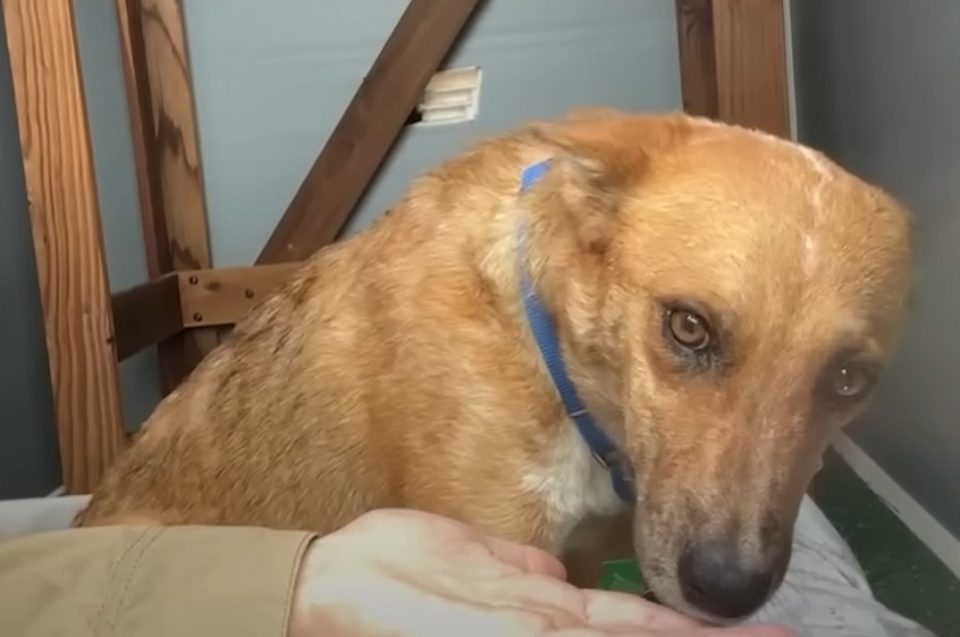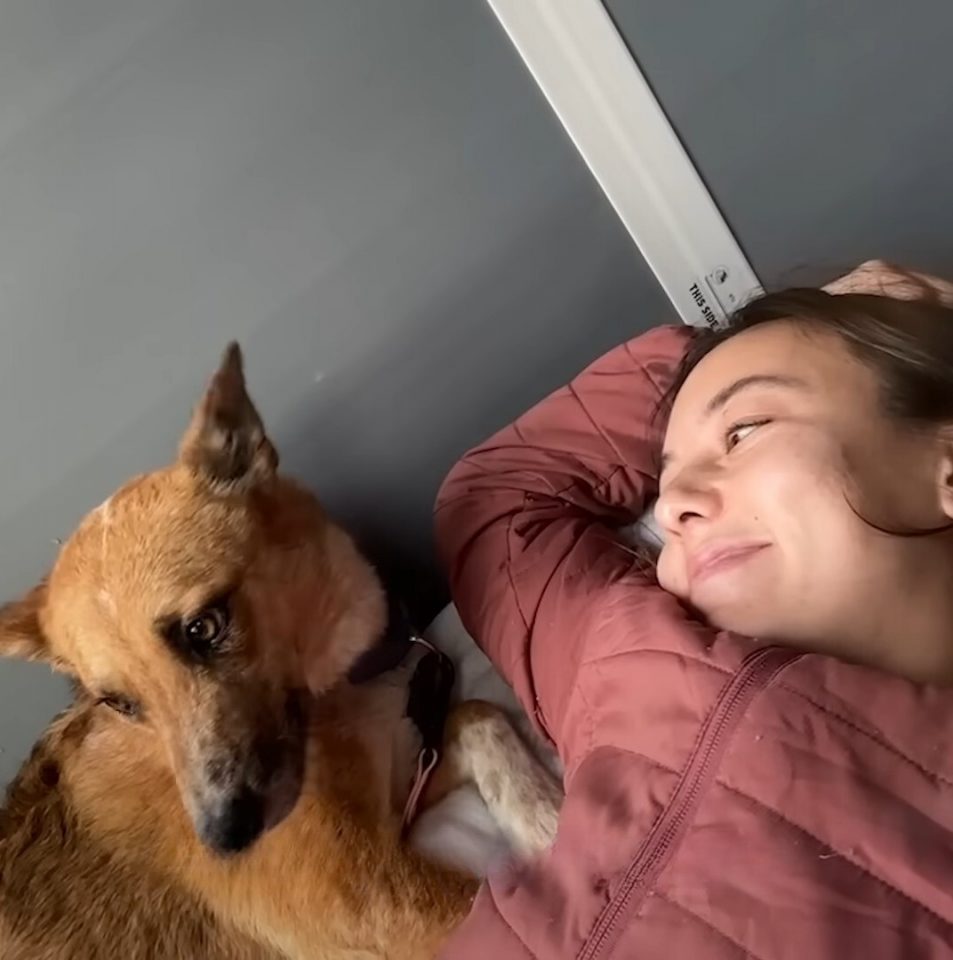Meet Wendy – a dog who was rescued by a group of wonderful people and given a new chance in a foster home in California.
Her foster mom immediately took notice of how unsure she was about entering her house, but she was willing to sleep in a shed, so that’s where Wendy slept for a while.
While her foster is doing everything to help her overcome this fear, it’ll take some time before it happens.
She Was Making Progress

Wendy’s foster mom told The Dodo: “She was just honestly terrified. The shed did become her safe space. She loved it.”
Because she was a naturally timid dog, she knew it was a matter of patience and perseverance until she changed.
She had both and was looking forward to spending time with Wendy and helping her learn how to live a normal life.
On one very ordinary day, she noticed that the dog had started showing interest in entering the house but was reluctant nevertheless.

She noticed that this adorable pup was looking for her attention and knew it was only a matter of time before she mustered up the courage to enter the house.
The change in her attitude was pretty apparent and she was a lot more outgoing as days went by. It was also a lot more noticeable when they played outside.
Wendy Is Ready For A New Life

The dog actually just casually walked inside, and it was such a big moment for her. Her foster mom was so proud.
She said: “And then before I knew it, she was sitting right next to me. And asking me for pets and trying to give me face kisses.”
Now that she was much braver and happier, her foster mom introduced Wendy to her dog and the two became friends in an instant.

Her foster mom said: “She started to come out of her shell and started to be a dog. She is a total maniac now.”
She has shown such determination and courage in the time she spent with her foster family. It’s really amazing to see how such small but important steps can change a dog’s life.
Wendy is still living with her foster mom in California, but they are looking to find her a new family and a wonderful home where she will be loved.
Ever looked at your furry friend and wondered about their age? Understanding your dog’s age is like unlocking a secret timeline of their life. From playful puppy days to wise old companion, each stage brings its own charm. As a seasoned dog enthusiast, you know that age is more than just a number for your canine pal.
Your dog’s age isn’t just about counting the years; it’s about decoding their behavior, health needs, and overall well-being. With each passing year, they leave pawprints on your heart, marking milestones in their journey alongside you. So, how old is your dog, really? Let’s embark on a journey to unravel the mystery behind your loyal companion’s age.
Understanding Dog Aging
Understanding how old your dog is can provide valuable insights into their health needs and behaviors. Here we’ll break down the key aspects of dog aging to help you better care for your furry friend.
1. Dog Aging Basics
Knowing your dog’s age is essential in determining their life stage. Just like humans, dogs go through different life phases with specific requirements.
2. Age-related Health Concerns
As dogs age, they may develop health issues such as arthritis, dental problems, or obesity. Understanding their age can help anticipate and manage these issues effectively.
3. Behavioral Changes
Age can influence your dog’s behavior, affecting their energy levels, playfulness, and even cognitive abilities. Recognizing these changes can aid in providing appropriate mental stimulation and care.
4. Tailored Care
Different ages require different care routines. Whether it’s nutrition, exercise, or veterinary visits, tailoring your approach to your dog’s age is crucial for their overall well-being.
5. Quality Time Together
By understanding your dog’s age, you can make the most of your time together. Adjusting activities and creating meaningful experiences based on their age can strengthen your bond.
Remember, acknowledging and understanding your dog’s age is the first step towards ensuring a happy and healthy life for your beloved pet.
Factors Affecting Dog Age Calculation
When determining your dog’s age, there are several key factors you need to consider to get an accurate estimation. Here we outline these essential elements:
Breed Specifics
Different dog breeds age at varying rates. Larger breeds, like Great Danes, tend to have shorter lifespans compared to smaller breeds like Chihuahuas. The size and genetics of your dog play a significant role in calculating their age equivalently.
Health History
Your dog’s overall health status affects how they age. Regular vet check-ups, vaccinations, and a healthy diet can all impact your dog’s longevity. Health issues can accelerate or decelerate the aging process, making it crucial to monitor your dog’s well-being.
Lifestyle Factors
The way your dog lives can influence how they age. Factors such as exercise, nutrition, and mental stimulation can all contribute to their overall health and impact their age. A well-balanced lifestyle can help your dog age gracefully and maintain vitality.
Dental Care
Proper dental hygiene is essential for your dog’s overall health and can affect their age calculation. Dental issues can lead to various health problems that may shorten your dog’s lifespan. Regular dental care is key to ensuring your dog’s well-being.
Environmental Influences
The environment in which your dog lives can also affect their age. Factors like pollution, climate, and living conditions can impact your dog’s health and longevity. Providing a safe and healthy environment is crucial for ensuring your dog ages well.
By considering these factors when calculating your dog’s age, you can gain a better understanding of their overall well-being and provide them with the care they need at every stage of life.
Calculating Dog’s Age in Human Years
To estimate your dog’s age in human years, you can’t simply use a 1:1 ratio. Dogs age differently than humans, and their aging process varies depending on factors like breed and size.
Age Conversion Formula
Here’s a rough guideline to convert your dog’s age into human years:
- The first year of your dog’s life is equivalent to about 15 human years.
- The second year is similar to around 9 human years.
- After that, each year can be considered as about 4-7 human years, depending on the size and breed of your dog.
Breed and Size Matters
Consider your dog’s breed and size when calculating their age. Larger breeds tend to have shorter lifespans and age faster than smaller breeds. For instance, a Great Dane may be considered a senior at 6-7 years, while a Chihuahua might still be active and healthy at that age.
Health and Lifestyle Impact
Your dog’s health and lifestyle play a crucial role in aging. Regular exercise, a balanced diet, and proper healthcare can significantly impact your dog’s age-related health concerns and overall well-being.
Dental Care and Environmental Factors
Don’t overlook the importance of dental care and environmental influences. Proper dental hygiene can add years to your dog’s life, while factors like stress and climate can affect their aging process.
By understanding how to calculate your dog’s age in human years and considering these factors, you can ensure that your furry companion receives the care they need at every stage of their life.
Canine Aging Signs
When it comes to determining how old your dog is, there are specific signs to look out for that can give you an indication of their age. Understanding these signs is essential for providing proper care and addressing any age-related concerns. Here are the key canine aging signs to watch for:
1. Physical Changes
- Gray Hair: Just like humans, dogs can also develop gray hair as they age, particularly around the muzzle.
- Loss of Muscle Mass: Older dogs may experience a decrease in muscle tone and mass.
2. Behavioral Changes
- Lack of Energy: Senior dogs tend to be less active and may show decreased energy levels.
- Changes in Sleep Patterns: Older dogs might sleep more and be less interested in activities they once enjoyed.
3. Health Issues
- Joint Problems: Arthritis and other joint issues are common in older dogs.
- Dental Concerns: Dental issues can worsen with age, leading to problems like tooth decay and gum disease.
4. Vision and Hearing Loss
- Diminished Senses: Aging dogs may experience a decline in vision and hearing.
- Forgetfulness: Older dogs may exhibit signs of cognitive decline and memory loss.
- Confusion: Seniors dogs may become disoriented or confused more easily.
By paying attention to these aging signs in your dog, you can better understand their needs and provide them with the care and support necessary to ensure their well-being as they grow older.
Longevity Tips for Dogs
When it comes to ensuring your furry friend lives a long and healthy life, there are some key tips to keep in mind. Here are some longevity tips to help your dog thrive at every stage:
Balanced Diet:
- Feed your dog a balanced diet suitable for their age, size, and breed to maintain optimal health and prevent obesity, a common issue in aging dogs.
Regular Exercise:
- Engage your dog in regular exercise to keep them physically fit and mentally stimulated. Exercise helps maintain muscle strength and joint flexibility.
Veterinary Check-ups:
- Schedule regular vet check-ups to monitor your dog’s health and catch any potential issues early. Early detection can lead to better treatment outcomes.
Dental Care:
- Take care of your dog’s dental health by regular teeth brushing and dental check-ups. Poor oral hygiene can lead to various health problems.
Quality Sleep:
- Ensure your dog has a comfortable and quiet sleeping space to promote good quality sleep. Sufficient rest is crucial for overall well-being.
Mental Stimulation:
- Keep your dog mentally stimulated with interactive toys, training sessions, and engaging activities to prevent cognitive decline and boredom.
Emotional Well-being:
- Provide a loving and secure environment for your dog to reduce stress and anxiety, which can impact their overall health and longevity.
- Create a safe and secure environment both indoors and outdoors to prevent accidents and injuries that could affect your dog’s quality of life.
By incorporating these longevity tips into your daily routine, you can help your dog live a long, happy, and healthy life by your side. Remember, your dog’s well-being is in your hands, so give them the love and care they deserve to thrive for years to come.
Conclusion
That’s all about understanding how old your dog is and why it matters. By knowing your furry friend’s age, you can provide the best care possible. Remember, each stage of your dog’s life comes with its unique needs and challenges. By following the longevity tips mentioned, you can ensure your dog stays healthy, happy, and by your side for years to come. Keep up with the vet visits, feed them well, give them plenty of exercise, and show them all the love they deserve. Here’s to many more tail-wagging years with your beloved canine companion!
Frequently Asked Questions
Q: Why is it important to know a dog’s age?
A: Understanding a dog’s age helps address their specific health needs and behaviors effectively, ensuring appropriate care at various life stages.
Q: What are some age-related health concerns in dogs?
A: Age-related health concerns in dogs may include arthritis, cognitive decline, dental issues, vision or hearing loss, and decreased immune function.
Q: What factors affect accurate age calculation in dogs?
A: Factors like breed size, genetics, diet, exercise level, and overall health impact accurate age calculation in dogs.
Q: What are signs of aging in dogs to watch for?
A: Signs of aging in dogs may include gray hair, decreased activity level, changes in appetite, cloudy eyes, and behavioral shifts.
Q: How can owners help their dogs live longer lives?
A: Owners can promote longevity in dogs by providing a balanced diet, regular exercise, veterinary care, dental hygiene, quality sleep, mental stimulation, emotional support, and a safe living environment.
[no_toc]

Hey there, I’m Janet Brooks, a dog-loving student from California. I’m all about helping pups in need, especially those without homes. Me and my awesome friends work together to give shelter and love to stray dogs. Oh, and I also write blogs about dogs to share helpful info.